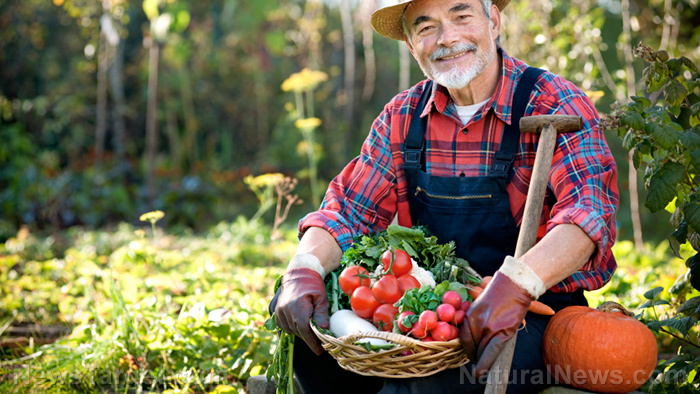
Starting a home garden is a great way to add to your food stockpile before SHTF. But this is a project that requires a lot of planning, especially if you plan to turn your home into a homestead.
To make the transition easier, learn about the basics of home gardening, make sure you have enough water for your crops and consider raising animals on your homestead. (h/t to Survivopedia.com)
Prepping and planning for your homestead
Before SHTF, you shouldn't underestimate how much of food you'll need to grow to survive. When you're facing a long-term survival scenario, you'll need more than one week's supply of canned food and a container garden to keep your family well fed.
You can grow enough food in your backyard to feed your family, but you need to sit down and plan ahead before assuming that you have enough. If you want to turn your backyard into a home garden, you probably need to turn the whole backyard into a garden – not just two feet or so of land.
Gardening tips for beginner homesteaders
The average American adult will consume at least one ton of food a year. And 50 to 60 percent of your daily calorie intake is in carbohydrates, which your body breaks down into simple sugars to provide energy to your muscles.
You can get your carb intake mostly from grains and potatoes.
But since grains need a lot of room to grow, 100 square feet of garden plot will probably only produce enough wheat for a loaf of bread. To raise enough wheat to provide 50 percent of your calories, it will be easier to grow corn instead of grains.
You can turn corn into cornmeal, which will produce at least three loaves of bread in the same sized garden plot you would need for grains.
Aside from corn, you can also grow root crops like potatoes. If you have 100 square feet of garden plot, you can grow six to 13 pounds of potatoes. In some parts of the country, you might even get two harvests of potatoes per year so you can double that amount.
The average residential lawn is 10,871 square feet, including both the front and back yards. This totals a little less than a quarter acre. You still need to increase your productivity, which you can do by utilizing the space efficiently through methods like raised bed gardening, vertical gardening or other techniques suitable for urban homesteading.
Start your home garden now
Don't wait until SHTF before you start planning a garden and growing crops. By then, it might be too late because you also need to start seeds, plant and wait until your crops are ready for harvesting.
Additionally, it will take a year or so to prepare the soil for a good garden. You can plant in the garden the first year, but this doesn't guarantee a great harvest since it takes time for compost to break down and get mixed into the soil.
You will also need to invest time and money to turn your whole backyard into a vegetable garden. Use raised beds for the best yields.
To start raised beds, you'll need enough materials to build the beds and quality potting soil for your crops. You'll need more than one or two months to do this, and extra time for working in your garden.
Fruit trees should also be planted as soon as you can since you will have to wait a couple of years before they will bear fruit. The shortest time to produce fruit is three years for some dwarf fruit trees. But some standard trees need as long as ten years before they produce fruit.
Here are some fast-growing fruit trees to plant in your home garden:
- Apple trees –Apples trees are best grown in USDA Zones 3 to 8. Dwarf apple trees will start bearing fruit after two to three years but standard-sized trees can take up to eight years to bear fruit.
- Citrus fruit trees – Citrus fruit trees are great if you're in USDA Zones 8 to 10. The trees start to produce fruits the year after you plant them. You can expect a full harvest at least three years after planting.
- Mulberry trees – Best grown in USDA Zones 5 to 9, but some varieties are robust in USDA Zones 3 to 4. A grafted mulberry tree can produce fruit within 12 years and it will continue to provide berries for decades.
- Peach trees – Peach trees will grow in USDA Zones 4 to 9, but they will also thrive in USDA Zones 6 to 8. On average, a peach tree takes three years to bear fruit.
While you're starting your vegetable garden and waiting for fruit trees to bear fruits, start working on converting your home into a homestead immediately if you plan to provide for your family. Another option is to raise animals for food, but raising livestock will also require several years of preparation.
Start building your homestead in stages so you're not overwhelmed by all the things you have to do. Expand it slowly so you can learn how to run each section smoothly before starting another project.
Water for your home garden
A big garden will require a lot of water for your crops. This won't be a problem if you have access to municipal water. But when the power goes out and you don't have a water supply, you need to find water for your garden.
Before SHTF, make sure you have access to clean water for your garden. Address water issues by setting up a well or a rainwater harvesting system. Wells are a more secure source of water and they will provide you with water more consistently.
Meanwhile, a rainwater harvesting system is ideal for areas that have a lot of rainfall. The problem with both method lies in how you're going to store the water when SHTF.
When starting a homestead, you also need to learn how to conserve water. Sprinkling water when watering your crops can waste water because the water will often fall where it isn't needed.
You can address this by using underground soaker hoses to reduce the amount of evaporation and get the water right to the plant roots. (Related: Homesteading 101: How to conserve water on your property.)
Raising animals on your homestead
With animals like cows, goats, geese and chickens you will have access to byproducts like milk, eggs and meat.
Check local laws so you don't break any of them while growing certain crops or raising certain animals. If you plan on raising bigger animals like pigs, sheep or cows, it might be better to live outside of town.
Plan ahead and start as soon as you can if you want to turn your home into an efficient homestead with a garden and livestock for your food supply.
Sources include:
Please contact us for more information.
















